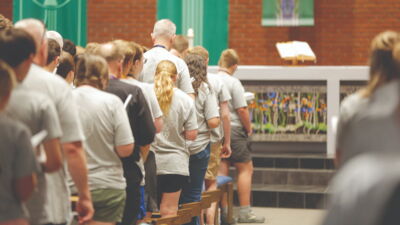What St. Patrick's Day Can Teach Us About God

Happy St. Patrick’s Day! Or, depending on when you’re reading this, happy late St. Patrick’s Day! For most of us, this holiday isn’t all that special – we don’t get a day off school to celebrate, and we don’t exchange presents or go to a special church service. So why should we care at all if we’re not Irish…or a leprechaun? Hint: it’s more than the fact that you might drive down to McDonald’s and get a Shamrock Shake.
The real St. Patrick – yes, he was a real person – was born in the late fourth century and is traditionally believed to have died around March 17 in 460 A.D.; that was, after he drove all the snakes out of Ireland. Okay, maybe that didn’t actually happen. Even so, we still dedicate an entire day to him in 2023! I’d like to make the case, therefore, that we as Christians should pay a little more attention to the man behind all of the green, rainbows, and four-leaf clovers.
Patrick was born in Britain and captured by the Irish at the age of sixteen. He spent six years as a captive in Ireland and subsequently escaped after hearing a voice that he believed to be God’s telling him that it was time to leave Ireland. While in Ireland, however, he turned to his faith as a comfort and became a devout Christian. After returning to Britain, he began to study Christian theology, and after fifteen years of study, became an ordained priest.
Interestingly enough, Patrick was sent back to Ireland – this time to minister to the Irish. He returned willingly, and not only did he strengthen the faith of the existing Irish Christian population, but he shared the faith with those who were not yet followers of Jesus Christ.
What stands out most to me about the figure of St. Patrick is that he did not try to eradicate the Irish people’s preexisting traditions. Instead, he showed them that the gospel of Jesus Christ could supplement and intertwine with their culture. He incorporated the nature-worshiping aspect of traditional Irish religion into his ministry by using nature to demonstrate the presence and love of God. According to one legend, Patrick used a three-leaf clover to teach about the Trinity, saying that the clover was one tiny plant with three distinct leaves. He created the Celtic cross, an image that combines the Christian cross with the sun, a popular Irish symbol.
As flowers begin to bloom and the snow begins to melt, revealing the grass underneath, we can tell that spring is coming. Just as St. Patrick ministered to the Irish people by showing them how nature is the ultimate demonstration of God’s love for all human beings, we too can do the same today, in 2023. I can remember a time when I was younger and was taught how the three-leaf clovers that populate my yard every spring can represent the doctrinal foundation of the religion that I hold so dear. “The heavens declare the glory of God, and the sky above proclaims his handiwork,” writes David in Psalm 19.
St. Patrick used what is all around us to show how God is always present, even in the little things (like three-leaf clovers)! This St. Patrick’s Day, and this spring, remember the real St. Patrick by taking time to look at the little things around you, remembering how God is in all of them. He’s in the blades of grass that slowly turn green as they recover from the cold of winter, he’s in the the buds on the trees that turn into tiny, soft leaves that give way to the blazes of green that shade us during the summer, and he’s even in the sticks and twigs that the birds carry in their mouths to make nests for their young. More importantly, he cares about all of these and doesn’t forget a single one.
“Are not five sparrows sold for two pennies? And not one of them is forgotten before God. Why, even the hairs of your head are all numbered. Fear not; you are of more value than many sparrows” (Luke 12:6-7). St. Patrick’s Day is the perfect time to reflect on God’s creation and presence. It may not be as “significant” of a holiday as Christmas or Easter, but it is one that can teach us so much about the nature of God.
Interested in reading more blogs? Find more quality content here.
Sources:
Editors, History.com. (2009, October 14). Who Was St. Patrick? History.com. https://www.history.com/topics/st-patricks-day/who-was-st-patrick.
Dawson, R. (2022, March 17). Who Was St. Patrick? (And Why Should Christians Celebrate St. Patrick’s Day?) Crosswalk. https://crosswalk.com/special-coverage/saint-patrick/who-was-st-patrick-and-why-should-christians-celebrate-st-patrick-s-day.html#:~:text=What%20St.%20Patrick%27s%20Life%20Reminds%20Us%201%20We,and%20His%20plans%20for%20us%20are%20good.%20.
Related Stories


